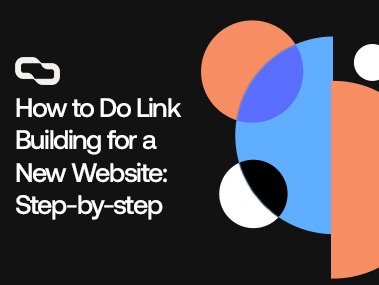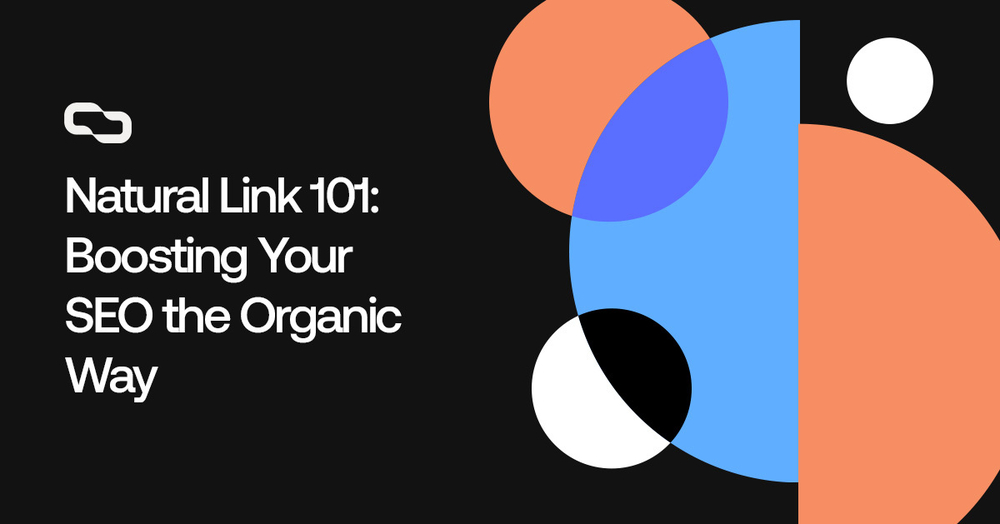Get links on brand new relevant articles for a boost of Authority and Relevance that’ll catapult your SEO. Our links include both DR and Traffic, so you don’t have to choose between one or the other.

Why should Google rank your new website?
I’m not a mind reader, but you probably answered with something that goes along with “I have excellent content.”
Well, I hate to break it out to you, but Google doesn’t give a F@$k.
Google is a revenue-based business.
They won’t spend their computing resources (money) crawling and ranking your new website unless you give them the right signals.
Some of these signals come from the great content you have.
But the most important ones come from backlinks.
We’ve built hundreds of new websites over the past decade.
And in this guide, I’ll share with you the exact link-building strategy we use to rank new websites step by step.
This tested and proven strategy will help you get out of the sandbox faster and rank your website higher with minimum resources.
Key Takeaways
- For new websites, gaining Google’s trust is paramount. Achieving this requires high-quality links, which signal power, relevance, and, most importantly, trust.
- Link-building should simulate real business behavior, including creating social profiles, listing in business directories, and acquiring mentions in news stories.
- Each link type serves a unique purpose, from offering authority signals to ensuring topical relevance, all vital for higher search rankings.
Link Building Goals for a New Website
For new websites, trust is the name of the game.
We must let Google know that we are a real business, not a spammer trying to play the system.
How to achieve that? You might ask.
By building links.
Backlinks provide three crucial signals to Google.
First, we have power, or what we call link juice.
Imagine your website as a container and the backlinks pointing to it as faucets funneling juice.
The more backlinks you get, the more juice will be funneled into your container, and the more powerful this page will be.
Second, we have relevance.
Google is an algorithm.
It can’t read your page and be like: “Yeah, this page is about the best protein powder for bulking.” Let’s rank it for this term.
Instead, it looks at cues, such as the page’s title, URL, keyword density, and many more.
One of the top cues Google looks at to understand the topic of the page is backlinks.
Here is how the algorithm thinks:
If you get a backlink from a website that talks about golf, there is a high chance that your page also has something to do with golf.
The more backlinks you get from golf sites, the more certain Google will be about your page’s topic.
We have an entire article that talks about the levels of backlink relevance and how you can use it to rank higher with fewer links, so make sure to check it out.
The final and most important backlink signal for new websites is trust.
Trust is often associated with EEAT (Experience, Expertise, Trust, and Authority).
And 90% of EEAT signals come from mentions on authoritative websites.
In other words, if a website that Google trusts links to you, it means that you are a legit, trustworthy business — by association.
Now, the thing is Google doesn’t trust new websites.
So they put them in what’s known as the Google sandbox — which is basically a probation period.
During this period, your pages will get indexed, but they won’t rank well in the search engine results pages (SERPs).
To break out of the sandbox faster, you must provide Google with the trust signals it craves.
And I’ll show you exactly how to do it in the next section.
Link Building Plan for a New Website
1. Social Profiles
What’s the first thing a new business owner would do — besides adding the word “entrepreneur” to their Twitter bio?
The answer is claiming their business social profiles.
They’ll create a Facebook page, an X (Twitter) account, change their title to Founder/CEO on LinkedIn, etc.
This is what real people do.
And it’s exactly the type of signals Google looks for.
So your first new website link-building task would be creating your social fortress.
Start with the most popular ones, such as Facebook, Twitter, YouTube, LinkedIn, Instagram, TikTok, and Pinterest.
Create your profiles, add your new website’s link to the bio & about sections, and then link to your social media accounts from your website’s about or contact page.
Even if you don’t intend to use these social channels right away, they are important to build trust.
Plus, you better claim your business name before someone else does.
2. Business Citations
Business citations are the digital equivalent of your business card.
They’re mentions of your company name, address, phone number, and website (NAPW) on online directories.
Directories? Who the hell still uses directories in 2024?
Only 94% of online users!
“I don’t care, I have an online business with no physical location, so citations won’t help me.”
Well, you couldn’t be more wrong!
When it comes to link building, your goal is to look natural.
Yes, links from directories are often no-follow and won’t help you rank higher on Google.
However, that’s what real businesses do.
And you are a real business, right?
Citation link building also has other benefits, such as helping Google find and index your website, diversifying your anchor text profile, and of course, making Google trust you more.
So, how to build business citations?
First, you should get a business location.
There are two ways to do it:
- The White Hat: You can reserve a PO box at USPS, get a virtual mailbox from services like Earth Class Mail, rent a business mailbox from UPS, or rent an office.
- The Black Hat: Search for “offices to rent in [city]”, and find an office you like, and that’s your new business address.
Now that you have your physical location, list your business on the four big citation websites: Yelp, Google My Business, YellowPages, and Foursquare.
Next, search for Best Directories in [Your City].
Join the top 5-10 local directories, and move on.
Finally, join business-related directories.
If you’re running a new pet website, list your site on pet directories and forums.
It can be a bit harder to find pet directories in your specific location but don’t overthink it.
Joining national directories is just as good.
Just remember: Consistency is your best friend.
Your NAPW should be identical across the board.
Why?
Because Google is like that strict teacher who wants your homework done just right.
Even the slightest variation can make Google second-guess your credibility.
Agency Tip: If you have a registered business, make sure to earn links from your local Chamber of Commerce. This link is super powerful and provides a lot of trust signals.
3. Web 2.0 Links
Web 2.0 platforms are any website that allows users to engage with each other.
So when we talk about Web 2.0 links, we basically mean links from social media platforms, websites like Wikipedia, forums like Instructables, Q&A websites like Quora, and platforms like Blogger, Medium, and Goodreads.
Although Google severely devalued the power of Web 2.0 backlinks, they’re still super important for new websites.
First of all, they’re natural to have.
If you are starting a new business, it’s just natural to hang out where your target audience is and engage with them on these platforms.
That’s what real business owners do, and what Google expects you to do as well.
So when Google sees that you get links from discussion forums, they think: “Oh, this business owner must be promoting their “real” business to real people.”
The second benefit of Web 2.0 links is visibility.
Having your website mentioned on these platforms allows Google crawlers to find your website — which will help index your website pages faster.
These links are also good for EEAT, as they suggest that there is a real person behind the brand.
Third, Web 2.0 websites can provide you with social signals and referral traffic — which are excellent for SEO.
Google collects a lot of data through its browsers and apps.
If they see that users are clicking on your website link and engaging with your content, it just tells them that users love your website, which gives them another reason to trust you.
Finally, Web 2.0 inbound links are excellent for tiered link building.
But that’s a more advanced link-building technique, so I don’t recommend doing it yourself if you’re just starting.
Where to get Web 2.0 links?
You can find a list of the top Wen 2.0 websites here.
But honestly, it’s such a chore, so I’d just buy a Web 2.0 package.
When it comes to link-building for a new website, I recommend building 10 Web 2.0 links.
4. Press Releases
Here’s a bit of an open secret: Many SEOs can’t stand PR links.
They roll their eyes, sigh heavily, and dismiss them as utterly pointless.
But here’s the juicy part — they couldn’t be more off the mark.
Seriously, let’s think about this logically for a moment.
Imagine your business just developed a technology that’s going to change the world.
Now, where would you expect to hear about such groundbreaking news?
From a casual blog or a random tweet?
No way!
You’d expect to see it blazing across news websites, both local and national.
Because, duh, that’s where real, earth-shattering news belongs.
And guess what?
Search engines love to see you getting mentioned in news stories because it’s the epitome of EEAT — especially the Authority and Trustworthiness parts.
How to get these juicy PR links?
Well, we have a full guide on how to do PR link building, so make sure to read it.
5. Utilize HARO Link-Building Techniques
Help a Reporter Out (HARO) is a matchmaking platform — but for journalists and sources.
Reporters need insights for their stories, and you, as an expert — or at least someone who knows a thing or two — provide those insights.
In return?
A mention of your business with a link back to your website.
The best thing about HARO is that it gives you access to journalists from top-tier media outlets like Forbes, Inc., and The New York Times.
I mean, can you even imagine the authority and trust signals a backlink from one of these giants sends to Google?
There is a catch, though!
HARO is extremely competitive.
Everyone and their dog is using HARO.
From huge PR teams to small affiliate website link builders.
This makes it really hard for you to stand out.
At least, without proper HARO link-building tactics!
In this guide, I share with you my top techniques to get high-quality backlinks from HARO.
6. Get High-Quality Links from Guest Posts
Guest posting is like being that cool guest on a talk show, except the talk show is a website, and instead of chatting about your latest movie, you’re sharing your expertise.
It’s about writing a piece of content for other websites, usually in your niche, and in return, you snag a precious backlink.
Now, guest posts are the best type of links you can get for a new website.
Why? You might ask.
Because you have full control over the links you build.
You decide the topic, craft the content, and choose the anchor text.
This helps you provide Google with the topical relevance signals it needs to understand and rank your content.
Plus, you get to cherry-pick the websites you build links on.
This is really important for new websites, as you want to be associated with high-quality sites from the beginning to get a higher trust score.
Other link-building strategies don’t give you this kind of freedom.
There are also other benefits of guest posting, such as increased brand visibility, referral traffic, building relationships in your niche, etc.
Here are a few easy ways to find guest post opportunities for a new website:
- Stalk Your Competitors (In a legal way, of course): Dive deep into their backlink profiles. Where are they guest posting? Time to get in on that action.
- Use Google Advanced Operators: Conduct a Google search using the following operator: intext:”Your Topic” AND “guest post” OR “guest author” OR “write for us”
- Monitor Your Inbox: You’ll be surprised by how many guest post opportunities land in your inbox, unannounced.
I recommend building 1-2 high-quality guest posts per week for the best results.
I’ll start by sending all the links to the home page for the first few months, then I’ll divide it 50/50 between the home page and inner pages moving forward.
FAQs
When Should I Start Building Links for a New Website?
You should start building links for a new website once most of your pages are indexed in Google. You can see the number of pages indexed by using the following search operator:
site:[Your Website URL]
How Many Links Should I Build for a New Website?
You should build between 4 and 10 backlinks per month for new websites. The exact number depends on your budget and the amount of organic traffic you receive. For more information, check our link velocity guide
What is link building and why is it important for a new website?
Link building involves acquiring hyperlinks from other websites to your own. It’s crucial for new websites because it boosts search engine visibility, enhances authority, and drives referral traffic, significantly impacting a site’s authority and search engine rankings.
What types of links are most valuable for a new website?
The types of links most valuable for a new website are what we call foundational links, such as social profiles, directories, citations, Web 2.0 links, and links from relevant pages.
Conclusion
For new websites, your goal is to look legit.
You want Google to trust you and think that you’re a real business with real people behind it.
That’s why your entire link-building strategy should revolve around replicating what real businesses do.
By following this guide, you’ll be able to get out of the sandbox and start experiencing an increase in organic traffic and leads within a few months.
We offer free customized link-building plans for new websites.
So if you need help with link-building, feel free to book a consultation call with one of our experienced link-builders.
Find out your exact cost of ranking for your dream keyword
Find out nowLet’s get you ranking now
If you want the team at Get Me Links to help you get more traffic
Book a call NOW Back to Blog
Back to Blog 12 Minutes Read
12 Minutes Read


